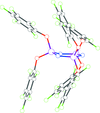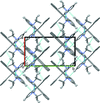issue contents
October 2019 issue

Cover illustration: Piperazine derivatives have long been known to show a broad range of biological activities; recently, N-(4-methoxyphenyl)piperazine (MeOPP) has appeared as a new designer drug, showing euphoric stimulant properties similar to those of amphetamines. Within this framework, the present study reports the molecular and crystal structures of a series of salts obtained combining MeOPP with simple organic acids in view of their possible pharmacological and pharmaceutical applications. In particular, the hydrogen-bonding patterns of the different derivatives have been fully described and are compared with those exhibited by some related compounds See: Kiran Kumar, Yathirajan, Foro & Glidewell [Acta Cryst. (2019). E75, 1494-1506].
research communications




































































 journal menu
journal menu



















































